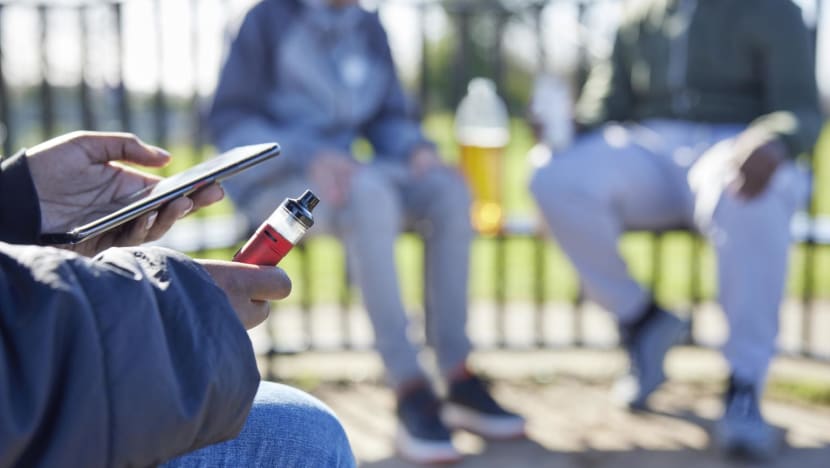Commentary: Teenagers know vaping is harmful. That doesn’t mean they’ll stop
Harsh laws against vaping and Kpods are necessary, but incomplete without youth inclusion, says writer and mother-of-three Cherie Tseng.

File photo of teenagers vaping in a park. (Photo: iStock/Daisy-Daisy)

This audio is generated by an AI tool.
SINGAPORE: My 15-year-old son recently came home from a student leader workshop and told me he’d spent the afternoon with former drug offenders.
The men he met spoke about choices they had made in their youth that slowly led to other risks and ultimately derailed their lives. Their stories included cigarettes, vapes, and increasingly, Kpods - vape pods laced with dangerous anaesthetics. Many said it started with curiosity, peer pressure, or "just trying it once".
My son said their stories didn’t feel like a lecture. They didn’t use scare tactics. They just straight up told their stories, plainly and honestly.
As a parent, I was struck by how formative the workshop was for my son.
Teenagers are often told what not to do. Don’t smoke. Don’t vape. Don’t take drugs. But if you really think about it, how often are they given the space to understand why, or to contribute to the conversations?
WHEN EVERYTHING IS ON FIRE, NOTHING IS
In recent months, there has been a visible crackdown on vaping in Singapore. Fines for users have increased, mandatory rehabilitation is now required for some offences, and suppliers of Kpods face caning.
Public messaging is everywhere. Posters warn of damage to the lungs, heart and brain. Schools echo the dangers during assembly time. Train stations and buses are blanketed with anti-vaping posters and warnings of penalties.
The message is clear, relentless and inescapable: Vaping and Kpods are dangerous, illegal, and offenders will be punished.
The level of coordination is striking, reminiscent of the days of the COVID-19 pandemic, when every institution spoke in unison.
As a parent of three school-going children, I’m reassured by the seriousness with which authorities are tackling the issue. When even primary school kids are being targeted at bus stops outside school - ergo, even my eight-year-old is a potential target - these measures send a strong signal that vaping and Kpods are not to be taken lightly.
But when I read that students who are caught vaping can now face up to 14 days suspension and three strokes of the cane, I find myself asking if fear alone can really stop teens from vaping? Or will it simply drive the habit underground?
Teenagers do not think like adults. Ask any young person, fear wears off fast. The worry with the current deluge, however needful on a level, is that this battle cry of deterrence lacks the nuance young people need to truly understand and engage.
“Youth psychology is different,” clinical psychologist Dr Kim Lian Rolles-Abraham of Better Life Psychological Medicine Clinic told me. “Label something as forbidden and it risks becoming alluring. Teens already know that vaping is harmful, but harmful can still be rebranded as cool or defiant. When the response is too harsh, the danger is not deterrence but alienation.”
She cautions that conflating vapes and Kpods might deepen the problem. “It creates the narrative of ‘at least I’m not on K-pods’,” said Dr Rolles-Abraham. Vaping then slips into the role of the lesser of two evils.
USE SCARE TOGETHER WITH CARE
To be pedantic, while Kpods and vapes are often mentioned in the same breath, they are not the same.
Vapes are electronic devices that deliver nicotine in flavoured aerosol form. Marketed as less harmful than cigarettes, they are still highly addictive and very harmful.
“Nicotine negatively affects brain development in areas tied to memory, learning, mood, and impulse control. The aerosol itself can damage the lungs, causing coughing, wheezing and shortness of breath - risks that are even more pronounced for adolescents whose respiratory systems are still developing,” Dr Ho Canxiang, lead physician at 1Doc Medical Centre, told me.
Kpods are even worse. These vape-pods are laced with anaesthetics like etomidate that can cause sudden blackouts, erratic “zombie-like” behaviour, and even respiratory collapse.
If we are serious about fighting this as a society, then the youths cannot be the target of messaging; they must be partners in shaping it.
History teaches us that fear alone rarely sustains long-term behaviour change. It may create compliance in the short term, but curiosity, peer pressure, or stress often override fear.
This is why a dual-prong approach - one that balances scare and care - is necessary. Harsh laws to punish users and suppliers must be balanced with empathetic, relatable education that respects youth agency.
Scare without care leads only to fear, shame and hidden behaviour. Care without scare drifts into soft messaging with no deterrence, which risks exacerbating the issue.
GIVE YOUTHS A SEAT AT THE TABLE
Teens listen to peers far more readily than to authority, which is why peer-led initiatives often succeed where top-down lectures fail.
When young people are given a seat at the table, they become advocates, not just recipients.
There are some models to draw from. In the United States, the Truth Campaign crafted its messaging for youths by making it look cool and rebellious to reject smoking and vaping. Instead of talking at youths, they used young people to bring the message to other youths, through social media, or at music and sports venues across the country.
In Hong Kong, the KELY support group engages young people through peer support, mentorship and leadership development. Their programmes are designed with youth, not just for them; focusing on peer-led trust and outreach, not just information dissemination.
Even locally, we have examples. My son’s workshop showed that when students hear real stories from real people, the message lands differently.
BOUNDARIES AND BRIDGES
Like most parents, I laud clear boundaries. I do not want my children to see vaping as harmless. But I also know that if they ever stumble, I’d want them to feel safe enough to tell me rather than hide in the fear of punishment. Boundaries and bridges.
As Dr Rolles-Abraham reminds me, conversations matter more than blanket labels: “When a teen knows you are coming from care and concern, they are more likely to open up.”
To this end, this fight against vaping and Kpods cannot be carried by policy alone.
The work of prevention is sustained through connection, conversation and collaboration with the very people most affected - our youth.
When young people are treated only as persons - or worse, problems - to be managed, they will hide. When they are treated as partners to be heard, they can advocate, impact and lead.
Giving them space to shape campaigns, to speak to peers and to sit at the table alongside parents, educators and policymakers can make the difference between surface compliance and genuine ownership.
I hope that when my children face tough choices, and invariably they will, they hear not just the alarms of crisis, but also the voices of connection and care.
Cherie Tseng is Chief Operations Officer at a local fintech company, a mother of three and editor with The Birthday Collective.


















